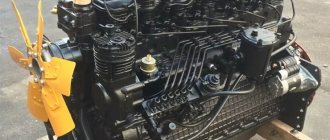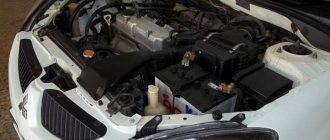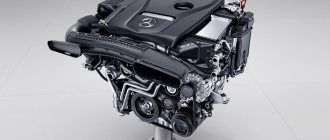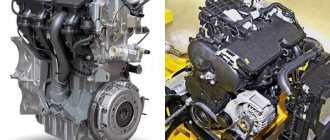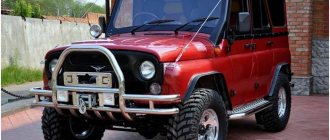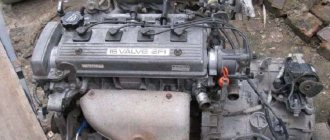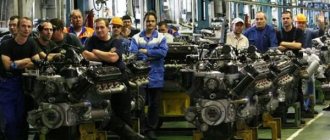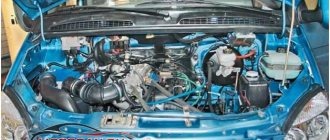About manufacturers
The SMD-22 engine belongs to the family of diesel power units that were produced in Soviet Kharkov.
In Soviet times, this was the most popular family of diesel engines for agricultural machinery - grain and forage harvesters, tractors of various traction classes produced by the Kharkov, Volgograd, Onega tractor plants and the Yuzhmash plant in Dnepropetrovsk, as well as for a variety of road construction equipment. In the last years of the existence of the Soviet Union, the SMD family, in addition to the SMD-22, also included:
The company traces its history back to 1881. Initially it was a factory for the production of agricultural equipment and implements. It was founded by German-born entrepreneur Max Helferich.
The workers of this enterprise never received decent money, so revolutionary sentiments were extremely strong in their team. In December 1905, the factory workers entered into a real war with the police and army, brought in to suppress the uprising. As a result of artillery shelling of the plant, one of its walls collapsed.
Immediately after 1917, factory workers en masse joined the Red Army. And the enterprise itself became the first nationalized plant in Kharkov, from which the owners and administration were expelled.
During the civil war, Kharkov changed hands several times; no more than three workshops operated at the plant, fulfilling defense orders of either the Reds or the Whites (repair of cannons, machine guns, armored trains).
Abandoned in Kharkov. Photo from 2011. Now these buildings are no longer there.
After the end of the Civil War, the plant was reconstructed and in 1922 it became known as the 1st State Agricultural Engineering Plant "Hammer and Sickle". He began producing tractor threshers, beet diggers and grain cleaning machines.
In 1941, they were involved in the production of military products, and as the front line approached, they were evacuated to Saratov. Despite severe destruction from the fighting, after the liberation of Kharkov the plant was restored and since 1944 began producing products - agricultural machinery. In 1949, a special design bureau (SKB) for engines was launched, and in 1950, Hammer and Sickle began mass production of engines (gasoline, for trailed combine harvesters).
Diesels of the SMD family began to be produced in Kharkov in 1958 (SMD-7, since 1962 - SMD-14). On June 1, 1967, the millionth diesel engine was produced at the plant. In the mid-1970s, it annually produced 200 thousand engines of more than a hundred modifications for a wide variety of equipment.
At the same time, new engines were developed within the SMD family - no longer four-, but six-cylinder - for combine harvesters. Also, operational tests confirmed the possibility of using SMD as a power unit for KamAZ, KrAZ trucks and LAZ buses.
A diesel engine design with a horizontal cylinder arrangement was developed. It was also planned to produce eight-cylinder engines. However, the introduction of new developments into production in the economic conditions of the 1990s turned out to be unrealistic.
The enterprise found itself in a difficult economic situation and was soon transformed into an open joint-stock company. In 2002, the plant produced only 275 engines, with a production capacity of 200 thousand engines per year.
In 2003-2005 bankruptcy proceedings were carried out at the plant. By 2015, nothing remained of the plant buildings.
The Belgorod Motor Plant began producing SMD diesel engines. This is a private enterprise specially created with the aim of fully mastering the mass production of the SMD diesel engine model range, and providing warranty and post-warranty service for SMD diesel engines, as well as converting trucks and buses to in-line SMD diesel engines.
Belgorod SMD diesel engines at the next agro-industrial exhibition.
The company has gone through a ten-year development path from a small private enterprise to a joint-stock company. The warranty for engines is 2 years or 2000 operating hours, and for the piston group - 5 years or 10 thousand operating hours.
Modifications of the D 6 motor
If we talk about the D 6 engine family, then it must be said that buyers were offered two modifications of this power unit, which were indexed D6 and D6U. Structurally, both of these motors are the same, with the exception of the drive chains used: for D 6 PR-12.7-900 GOST 10947-64; for D6U PR-12.7-1800-1 GOST 10947-64.
This power unit was air-cooled, which made it possible to significantly simplify the design of the motor. At the same time, thanks to the appropriate location of the combustion chamber, it was possible to completely solve the problem with thermal loading, eliminating the need to use an additional ribbed cylinder for effective cooling of the power unit.
The carburetors used and the entire power system were reliable, and the efficiency of the engine made it possible to reduce the costs of its operation. No carburetor maintenance was required. You just need to remember that, like most of these motorcycle engines, this engine runs on a mixture of gasoline and oil.
Engine design SMD-22/22a
In any modification, it is an in-line, 4-stroke, 4-cylinder engine with turbocharging and liquid cooling. The cylinders have a working volume of 6.3 liters.
Main components of the SMD-22/22a engine:
The SMD-22 engine starting system is represented by the P-1OUD starting engine, on which the RPD1.OOO M gearbox is mounted.
Combine harvester SKD-6 M "Sibiryak"
During the intake stroke, air pre-compressed by the turbocharger enters the cylinder through the open intake valve. When the piston moves with the valves closed, the air in the cylinder is compressed, and its temperature rises significantly. At the end of the compression stroke, diesel fuel is injected through the nozzle into the combustion chamber of the piston. Sprayed and mixed with compressed air, it spontaneously ignites. The gases generated during the combustion of diesel fuel, expanding, put pressure on the bottom of the piston, and force it to make a working stroke. The movement is transmitted through the piston pin and connecting rod to the crankshaft crank, rotating it.
After the piston completes its power stroke, the exhaust valve opens and the piston pushes the exhaust gases out of the cylinder, producing the exhaust stroke. The cycle then repeats over and over again.
The working strokes in the engine cylinders follow one after another, according to the order of operation of the cylinders: 1-3-4-2.
For optimal operation, the opening and closing of the intake and exhaust valves do not coincide with the position of the piston at its dead center.
The engine uses oil cooling of the pistons, which allows to lower the temperature of the pistons in the area of the piston rings and generally increase the reliability of the diesel engine.
SMD engine: characteristics, malfunctions and tuning
The SMD engine is a diesel engine, well known to workers at machine and tractor stations (MTS), which were widespread during the existence of the USSR. The production of these engines was mastered in 1958 at Kharkov (1881). Serial production of the family of SMD engines intended for aggregating various types of agricultural machinery (tractors, combines, etc.) was discontinued due to the cessation of the enterprise's activities (2003).
The line of these power units includes:
- 4-cylinder engines with in-line cylinders;
- inline 6-cylinder;
- V-shaped 6-cylinder units.
Moreover, any SMD motor has very high reliability. It is embedded in original design solutions, which, even by modern standards, provide a sufficient margin of operational safety for these motors.
Currently, SMD type power units are produced at the Belgorod Motor Plant (BMZ).
Specifications
Download .xls file
Download picture
Send by email
| OPTIONS | MEANING |
| Slave. cylinder volume, l | 9.15 |
| Power, l. With. | 160 |
| Crankshaft rotation speed, rpm. nominal/minimum (idling)/maximum (idling) | 2000/800/2180 |
| Number of cylinders | 6 |
| Cylinder arrangement | V-shaped, camber angle 90° |
| Cylinder diameter, mm | 130 |
| Piston stroke, mm | 115 |
| Compression ratio | 15 |
| Cylinder operating order | 1-4-2-5-3-6 |
| Supply system | Direct fuel injection |
| Fuel type/brand | Diesel fuel “L”, “DL”, “Z”, “DZ”, etc., depending on the ambient temperature |
| Fuel consumption, g/l. With. hour (rated/operating power) | 175/182 |
| Turbocharger type | TKR-11N-1 |
| Starting system | Starting motor P-350 with remote start + electric starter ST142B |
| Starter fuel | A mixture of A-72 gasoline and motor oil in a ratio of 20:1 |
| Lubrication system | Combined (pressure + spray) |
| Engine oil type | M-10G, M-10V, M-112V |
| Engine oil quantity, l | 18 |
| Cooling system | Water, closed type, with forced ventilation |
| Motor resource, hour | 10000 |
| Weight, kg | 950…1100 |
The power unit was installed on tractors T-150, T-153, T-157.
Description
Diesel 6-cylinder V-shaped SMD engines are represented by a number of models SMD-60...SMD-65 and more powerful SMD-72 and SMD-73. All of these engines have a piston stroke less than the cylinder diameter (short-stroke version).
At the same time, in engines:
- SMD-60…65 uses turbocharging;
- SMD-72…73 charge air is additionally cooled.
The partitions between adjacent cylinders, together with the end walls of the crankcase, give the structure the necessary rigidity.
Each cylinder block has special cylindrical bores into which cylinder liners made of titanium-copper cast iron are installed. The layout of all engine components takes into account all the advantages provided by the V-shaped arrangement of cylinders. Placing the cylinders at an angle of 90° made it possible to place the turbocharger and exhaust manifolds in the camber between them. In addition, due to the displacement of the cylinder rows by 36 mm relative to each other, it was possible to install two connecting rods of opposite cylinders on one crankpin of the crankshaft.
The layout of the gas distribution mechanism parts differs from the generally accepted one. Its camshaft is common to two rows of cylinders and is located in the center of the crankcase. On the flywheel side, at its end there is a gear block, which includes gears for driving the gas distribution mechanism and the fuel pump.
During operation, the motor provides coarse and fine cleaning of diesel fuel. Engine oil is purified by a full-flow centrifuge.
The power unit is cooled with water. In winter, antifreeze can be used. The circulation of liquid in a closed cooling system is carried out thanks to a centrifugal water pump. A six-row tubular-plate radiator and a six-bladed electric fan also take part in the cooling process.
The SMD 60 engine cooling system also provides thermosiphon circulation of the coolant inside the water jacket of the starting engine. However, it is able to provide cooling of the latter only for a short time. To avoid overheating, the operating time of the starting engine at idle speed should not exceed 3 minutes.
Maintenance
Maintenance of the SMD 60 engine comes down to constant monitoring of the process of its operation and regular maintenance specified in the instructions for its operation. Only if these conditions are met, the manufacturer guarantees:
- long-term and trouble-free operation of the power unit;
- maintaining power characteristics throughout the entire service life;
- high efficiency.
Types of maintenance (MOT) are determined by the timing of their implementation depending on the number of engine hours worked:
- Daily maintenance – every 8…10 engine hours.
- TO-1 – after 60 hours.
- TO-2 – every 240 mph.
- TO-3 – 960 mph.
- Seasonal maintenance - before the transition to the spring-summer and autumn-winter periods of operation.
The list of work that must be carried out for each type of maintenance is given in the engine operating instructions. In this case, work requiring disassembly of the power unit must be carried out only in enclosed spaces.
Malfunctions
Failures of SMD 60 engines are rare and arise, as a rule, due to violation of the rules of their technical operation.
| FAULT | REMEDY METHODS |
| The release of crankcase oil through the exhaust pipe. | 1. Long-term operation of the engine at low and/or idle speeds. |
| 2. Coking of cast iron sealing rings on the turbocharger rotor shaft. | |
| 3. Large gap between the rotor shaft and the turbocharger bearing. | |
| Release of motor oil through the flywheel housing. | 1. The self-clamping oil seal is destroyed. |
| 2. The gearbox O-ring has been cut off. | |
| There is no oil supply to the valve mechanism. | 1. The camshaft bushing rotates. |
| 2. Clogged oil passages of the cylinder head. | |
| 3. Loosening of the camshaft gear. | |
| Extraneous knocks in the engine: | |
| 1. A loud, sharp knock. | The nozzle is broken. |
| 2. Detonating knock. | The injection angle is incorrect. |
| 3. Unclear knocking sound. | Broken valve guide; sticking of the pusher; connecting rod bearings were melted; the connecting rod bottom cover is loosened; crankshaft liners are melted. |
Tuning
Motors used to power agricultural machines and mechanisms are not subject to tuning. Developed for specific operating conditions, they are, as a rule, perfectly balanced and interference with their design does not lead to positive results.
Families of such engines are presented by manufacturers in the form of wide lines with different power levels. At the same time, they are installed on certain types of special equipment, from which consumers choose those that most fully meet their requirements.
dvigatels.ru
Crankcase and cylinder head of diesel engine SMD-22
The crankcase is the main body part of the engine. It houses parts of the crank and gas distribution mechanisms. The crankcase is a cast iron casting, the upper part of which forms the cylinder block, and the lower part is the upper part of the crankshaft housing.
In the upper part of the crankcase there are vertical bores in which the cylinder liners are placed. The cavity between the crankcase walls and the liners is used for the passage of coolant.
In the transverse partitions of the lower part of the crankcase, beds are bored out for mounting the crankshaft main bearings. The upper parts of the beds are located directly in the partitions, and the lower parts are in the main bearing caps. To ensure alignment of the main bearings, the boring of the beds in the crankcase is done complete with covers from one installation. Therefore, the main bearing caps are not interchangeable.
Crank mechanism SMD-22
The crank mechanism converts the rectilinear reciprocating movements of the piston into rotational movements of the engine crankshaft.
The main elements of the crank mechanism are pistons with piston rings and pins, connecting rods, a flywheel and a crankshaft.
The pistons are made of aluminum alloy and are equipped with three grooves for mounting piston rings - two compression and one oil scraper. Radial drillings are made in the grooves under the oil scraper rings, and inclined drillings are made under the grooves to drain oil.
The groove area under the upper compression ring is reinforced. The upper compression ring is made of high-strength cast iron, chrome-plated on the outer diameter and has a barrel-shaped working surface. The lower compression ring has a conical working surface.
An open-type combustion chamber is located in the thickened piston bottom. The piston skirt is oval-conical, with a large diameter at the bottom.
The piston pins are hollow, made of chromium-nickel steel. Their outer surface is cemented and polished. The pin is held by two retaining rings against axial movements in the bosses.
Connecting rods are stamped, made of steel. The connecting rod rod has an I-beam cross-section. A bimetallic bushing is pressed into the upper head of the connecting rod. To lubricate the piston pin, three holes are made in the upper head.
The lower head of the connecting rod is made detachable. The boring of the bed of the lower head of the connecting rod for the liner is done in the assembly with the cover, so the connecting rod and its lower cover are marked with digital marks, and the caps on the connecting rods cannot be replaced or rotated 180 degrees.
Connecting rod bearings are thin-walled, made of steel-aluminum tape with antifriction alloy A06-1.
The crankshaft of the SMD-22 engine is made of cast iron, with increased counterweights, four connecting rods and five main journals. Thin-walled liners with antifriction alloy AO2O-1 were used for the main bearings.
To improve oil purification and reduce wear of connecting rod bearings, cavities for oil purification, additional centrifugal type, are provided in the crankpins of the crankshaft. The cavities of the necks at the ends are covered with threaded plugs, cottered to prevent them from unscrewing themselves.
The axial force of the crankshaft is perceived by 4 steel-aluminum half-rings, which are located in the bore of the crankcase and the cover of the third main bearing. A gear block is mounted at the front end of the shaft. One gear drives the timing gears, and the other drives the oil pump. On the conical part of the front end of the shaft, a single-ribbed pulley for driving the fan and generator is located in a ratcheted position.
At the rear end of the shaft, a flywheel is attached to the flange with six bolts. The flywheel ensures uniform rotation of the crankshaft, removes the pistons from “dead spots”, and facilitates the process of starting a diesel engine. When installing the flywheel, the marks on the crankshaft flange and on the flywheel must match. To reduce knee vibrations, the shaft and flywheel are balanced using dynamic balancing.
Gas distribution system SMD-22
The diesel gas distribution mechanism ensures the intake of fresh air into the cylinders and the removal of diesel combustion products. The gas distribution mechanism is equipped with a suspended valve system and consists of a camshaft, intake and exhaust valves, elements for their installation and drive (guide bushings, springs, plates with crackers, pushers, rods, struts, rocker arms, axles and adjusting screws with nuts.
The camshaft is steel, on three supports. The crankshaft support journals are made of different diameters. The anterior neck has the largest diameter. A channel is drilled in the rear neck to supply oil to the valve mechanism.
The surface of the necks and cams is hardened by high-frequency high frequency. The camshaft is driven into rotation by the crankshaft through distribution gears, which are located in a special crankcase in the front of the block.
The axial play of the camshaft is limited by a thrust screw, which is located on the front cover of the timing gears.
Diesel fuel supply system SMD-22
The fuel supply system is designed to clean and supply atomized diesel fuel into the working cavities of diesel cylinders in quantities that correspond to its operating mode.
The power supply system includes: a fuel pump with a regulator, a booster pump with a manual diesel fuel pump, nozzles, diesel fuel coarse and fine filters, low and high pressure fuel lines, a fuel tank.
The quality of engine operation depends on how clean the diesel fuel in the tank is and whether there are any impurities of water and air in it. To achieve the required purity, diesel fuel from the tank first passes through a coarse filter, in which it gets rid of large mechanical impurities and water. Then the fuel is sucked in by the fuel pump and fed under pressure into the fine filter.
The diesel fuel purified in this way enters the fuel pump, which drives it through high-pressure pipes to the injectors. When the diesel fuel pressure reaches the injector spring tension pressure, the injector atomizer needle rises and fuel is injected into the combustion chambers.
Diesel fuel that leaks through the gaps into the upper part of the injector body will be discharged through the drain pipe into the fine filter. Excess diesel fuel supplied by the fuel priming pump will return to the priming pump through the drain valve in the fuel pump head via the bypass tube.
If there are problems with the engine, which can be expressed in smoky exhaust, a decrease in power, missed flashes, or difficult starting of the engine, it makes sense to check the fuel equipment, first of all, the condition of the fuel filters.
Piston internal combustion engine with compression ignition
Main article: Diesel engine
In a diesel engine, fuel ignition occurs without a spark plug. A portion of fuel is injected into the air heated by adiabatic compression in the cylinder through a nozzle and atomized. When spraying, combustion centers appear around individual evaporating drops of fuel, and as injection proceeds, a portion of the fuel burns in the form of a torch. Since diesel engines are not subject to detonation (due to the start of fuel supply and combustion after TDC of the compression stroke), the compression ratio is not limited by detonation. Increasing it above 15 practically does not increase efficiency, since in this case the maximum pressure is limited by longer combustion and a decrease in the injection advance angle. However, small-sized swirl-chamber diesel engines can have a compression ratio of up to 26, for reliable ignition under conditions of large heat dissipation and for less harsh operation. Large-sized supercharged marine diesel engines have a compression ratio of about 11..14 and an efficiency of more than 50%.
Diesel engines are usually less fast, therefore, with equal power to gasoline engines, they are characterized by greater torque on the shaft. Large diesel engines are designed to run on heavy fuels, such as fuel oil. Large diesel engines are usually started using compressed air, or, in the case of diesel generator sets, from an attached electric generator, which acts as a starter when starting.
Modern engines, called diesel engines, do not operate on the Dies cycle.
Diesel lubrication system SMD-22
The lubrication system includes: an oil pump with an oil receiver, a centrifuge, an oil radiator, oil channels, oil lines and a turbocharger oil filter.
It is intended for uninterrupted supply of oil to the rubbing parts of the engine, with the aim of reducing friction and wear of parts, as well as to remove heat and wear products from them. It is combined: one part of the parts (main and connecting rod bearings of the crankshaft, camshaft bearings, valve mechanism, intermediate gear bushings and fuel pump gears), the other (liners, pistons, rings, piston pins, camshaft cams, pushers, gears) - by splashing : oil leaking from bearings.
In addition, the layer of lubricant that is on the surface of the liner, rings and piston forms a seal at the liner-piston connection.
Cooling system SMD-22
The cooling system includes a radiator, water pump, fan, water cavities in the block and cylinder head. The cooling system is needed to remove heat from the hottest engine parts (liners, block, cylinder head) and ensure acceptable thermal conditions during diesel operation. You can use water or antifreeze as a coolant. Its closed forced circulation is provided by a centrifugal water pump.
For automatic temperature control, the motor has a TS-107 thermostat.
Specifications
| Model | SMD-22 |
| Rated power, kW (hp) | 106,7 (145) |
| Operating power, kW (hp) | 103 (140) |
| Rated rotation speed, rpm | 2000 |
| Minimum stable idle speed, no more than rpm | 650 |
| Maximum idle speed, no more than rpm | 2130 |
| Specific fuel consumption at rated power mode, no more than g/kWh (g/hp.h) | 224 (165) |
| Specific fuel consumption at operating power mode, no more than g/kWh (g/hp.h) | 233 (171) |
| Oil pressure in the main line of the diesel lubrication system at steady state operating mode and coolant temperature 80–95°C MPa (kgf/cm2): - at rated speed - at minimum stable idle speed, not less |
© 2010–2019, Belgorod Motor Plant CJSC
+7 (4722) 500-527
sales department phone number
Source
Reviews of SMD-22 engines
The SMD-22 is known as an affordable, easy to maintain and repair, durable, reliable and unpretentious motor. With proper operation and regular maintenance, the service life before major repairs is at least 10 thousand hours. The motor does not need to create new service centers, since in Russia more than a hundred enterprises can repair this “classic” without any problems - SMD engines are known to everyone. Despite the archaic nature of this model, the use of this type of engine as a power unit for agricultural machinery, special equipment, and mobile power plants still has broad prospects in Russia.
Source
Torque
Engine h4md438 technical specifications
Another important characteristic in the list of main indicators for internal combustion engines is torque. Obviously, the greater this characteristic, the better the car will accelerate and drive. However, to understand how important this indicator is, it is worth understanding what it means.
Technical documentation always displays torque in units such as newton meters. Analyzing this formulation in the literal sense, we can come to the conclusion about how much force the engine applies to the wheel to move the car one meter.
What does this give? Firstly, more force allows the wheel to pick up speed faster. Provided that the tires on the car are not “bald” and the road surface is not icy, such a car will accelerate more intensely.
In addition, applying more force simultaneously reduces fuel consumption, since the engine has to spend much less energy to achieve the same acceleration time as a car with a less powerful power unit.
The peculiarity of torque is that the characteristic indicated in the documentation is relevant only for a certain number of revolutions - as a rule, these revolutions are in the red zone of the tachometer. If the number of revolutions differs from the set one, then the torque is much less, and only the operation of the turbine can increase it.



